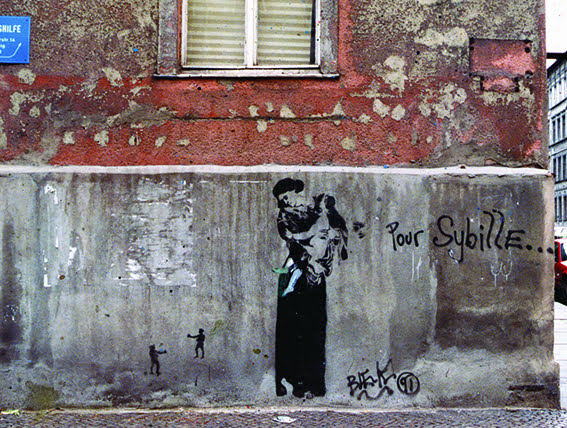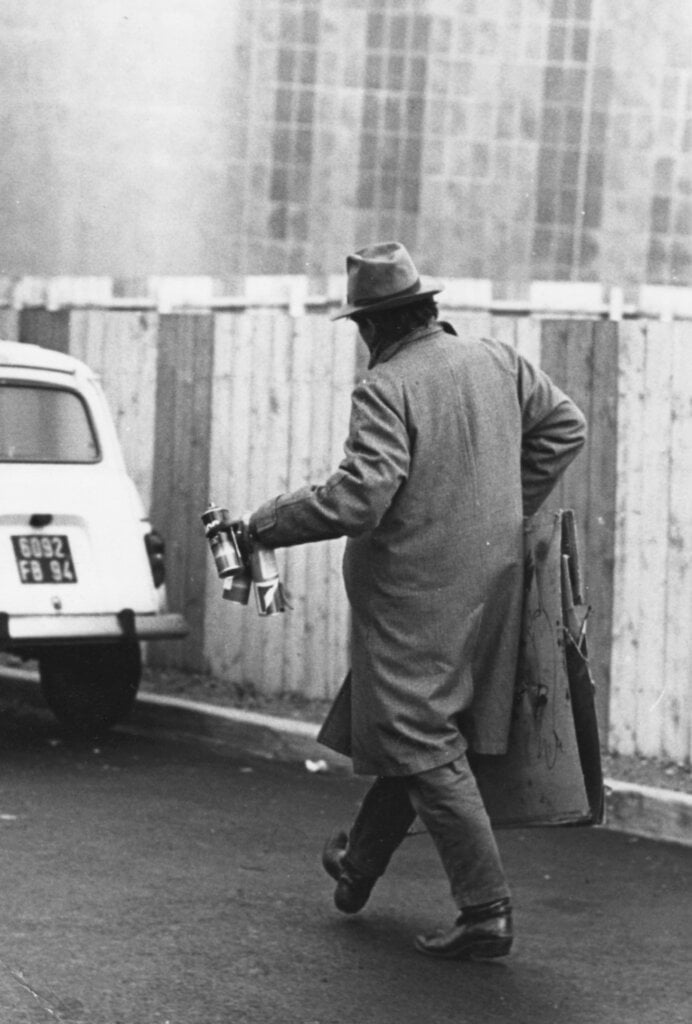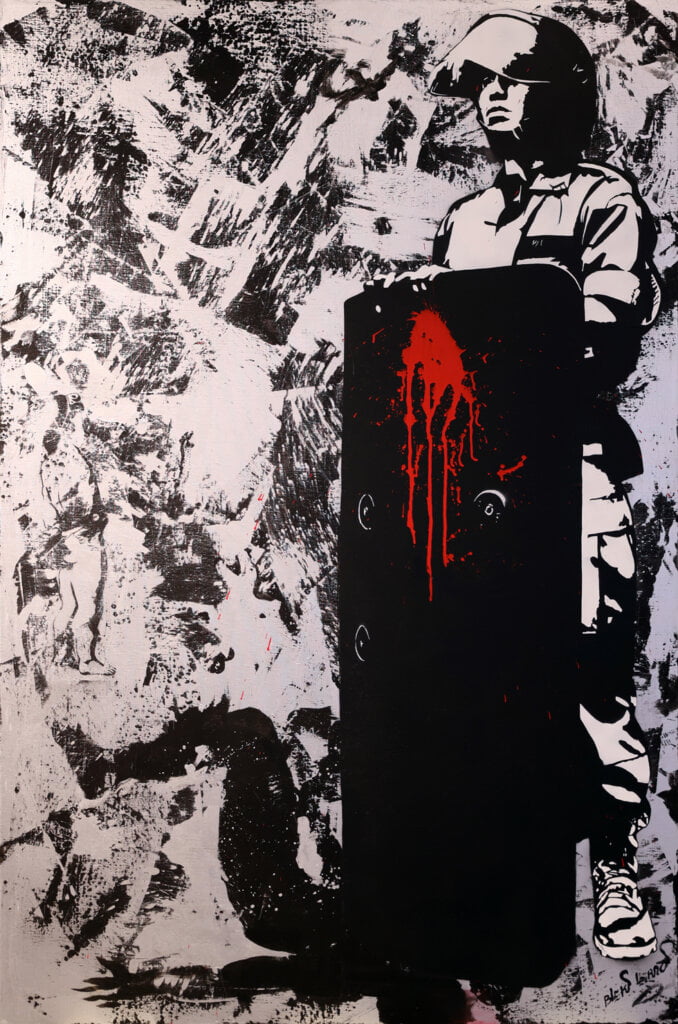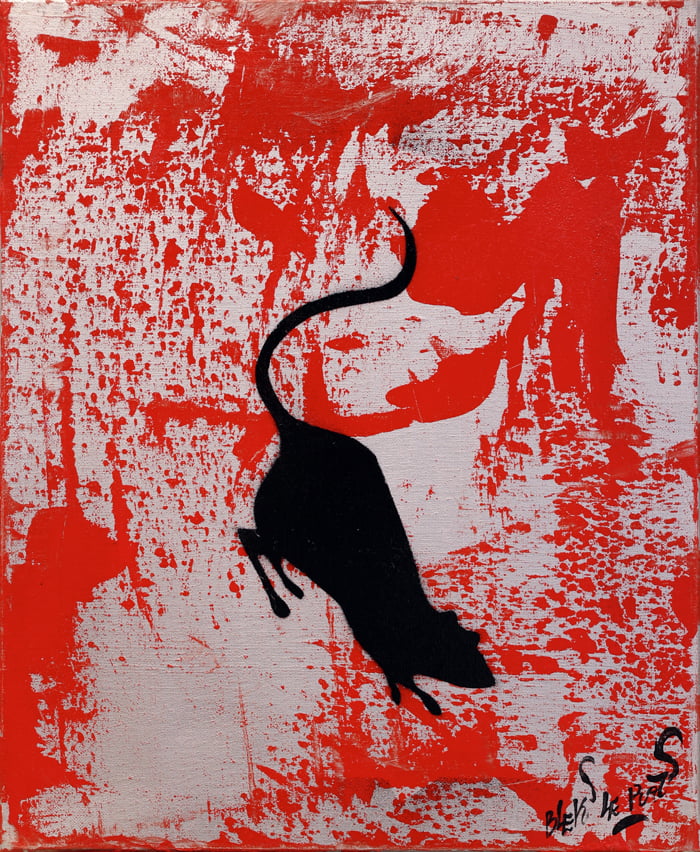Paris underwent political, social, and cultural change in the 1980s. The air charged with anticipation as the tapestry of history was about to be rewoven, making it fertile ground for an artistic renaissance; the city became a playground for creative minds, a period of reawakening forever inscribed in history. Amidst this creative fervency, a spray-painted rat began to make its presence felt, gracing the Parisian streets and architecture with its distinct silhouette.
This enigmatic motif was the clandestine signature of artist Blek le Rat, an uncanny symbol of the times. Yet his artistic prowess lay not only in his arresting social observations, masterfully rendered in stencil, but in his ability to find the most fitting locations to maximize the impact of his thought-provoking statement.
Born in 1951 as Xavier Prou, Blek’s journey into street art was ignited during his visit to New York in 1972; it was there that he became fascinated by the city’s burgeoning graffiti-art scene, which firmly grasped his curiosity, acknowledging the memorable artist Richard Hambleton‘s sinister Shadowman figures which left an indelible mark on Blek’s artistic consciousness.
The power of working on the streets is the most impactful form of art there is.
Blek le Rat
Returning to Paris, Blek spawned his own aesthetic onto the urban terrain, initially painting stencils of rats on the walls, describing the Rat as ‘the only free animal in the city’ and a creature that “spreads the plague everywhere, just like street art.” Drawing inspiration from the comic book Blek le Roc, which he used to read as a child, he adopted the pseudonym “Blek le Rat,” with “rat” being an anagram for “art “.
By 1985, Blek had become integral to the inaugural graffiti and urban art movement gathering in Bondy, France, with the VLP’s. A captivating 1991 replica of Caravaggio’s Madonna di Loreta, dedicated to his future wife Sybille, was unearthed behind posters on a Leipzig house wall in 2012, marking Blek’s oldest preserved work. In 1991, French authorities unveiled Blek’s identity after apprehending him while he stencilled a replica of Caravaggio’s Madonna and Child; this compelled him to shift his focus exclusively to pre-stencilled posters, a medium allowing for faster application and reduced repercussions.
Today, Blek le Rat is widely renowned, with his stencils etched across the globe, earning him the moniker of ‘The Father of Stencil Graffiti.’ His unwavering commitment to social consciousness and democratising art has inspired many. His poignant portrayals of evocative imagery reveal what must soon come to pass, imploring viewers to confront global issues’ harsh realities.
Now, after a decade, Blek le Rat returns to the UK, showcasing a new body of work in his highly anticipated exhibition, ‘The Return of The Rat,’ at Woodbury House and a fresh stencil piece in London’s Leake Street to celebrate his return.
In the annals of art history, legends attain a near-mythical status, revered for their technical prowess, innovation, and profound insights into the human experience. And Blek le Rat is no exception. His impact on contemporary graffiti art and guerilla-art movements is undeniable, and his work continues to captivate audiences to this day. We honour these individuals as Légende de l’art!
In this interview, we learn about his well-trodden path as an artist, his work and what’s next for him.
Blek le Rat, ‘The Return Of The Rat’, is until 12th April 2023 at Woodbury House
Hi Blek! How are you doing? Thank you for taking the time to speak with us. Can you please introduce yourself to those who do not know you?
Blek le Rat: My name is Xavier Prou, alias Blek le Rat. I am a French artist born in 1951 in Paris, and I have devoted my life to street art, particularly Stencil Graffiti. I am often referred to as ‘The Father of Stencil Graffiti’.
How did you first become interested in street art, and what inspired you to choose stencil graffiti as your primary medium?
Blek le Rat: I visited New York in 1972 with my good friend Larry Wolhandler. I was amazed to see the walls; they were covered in what I know now as graffiti. I had not witnessed this before, and it amazed me what I was seeing. I travelled back to France; the French architecture is very different to New York, and I did not wish to replicate what I saw in the streets of New York in Paris. I identified stencil graffiti as the perfect medium for French architecture, and this is where my career began.
Many people consider you a pioneer in the world of stencil graffiti. What do you think sets your work apart from other street artists?
Blek le Rat: I am considered the pioneer of stencil graffiti as I was the first artist to do this, it was never done before in the form I was doing it in. I took what I had seen in New York and fused my own style and genre within the graffiti movement, so it was the character and my twist on what I felt was right for the French streets. What sets my work apart is that I do not try to imitate American Graffiti or other graffiti segmentations. I bring a new vision of street art through the stencil form. Aesthetically, I love the human-size stencil, not the mural aspect. This is far more genius as it is crucial that you place them in the right setting and environment in order to make the best impact.
The Rat is a motif that is synonymous with your work. Can you tell the essence behind the Rat and why you used it in your work?
Blek le Rat: Paris is full of Rats. There are more Rats in Paris than people. The Rat is the only free animal in the city. Rats intrigue me; they are ingenious animals, they work together, they are protective, and if the world were to flood today, rats would be the only survivor. Rat is also an anagram of ART.
Can you share a memorable experience or challenge you faced while creating graffiti on the streets of Paris?
Blek le Rat: My early memories of stencil graffiti, the police did not bother me; they used to stop me and say are you doing something political, I said no art, and they would say, ok, carry on, which is a very funny memory. The fondest memorable work in Paris was following the kidnapping of French journalist Florence Aubenas in Iraq. I pasted hundreds of prints of her image around Paris.
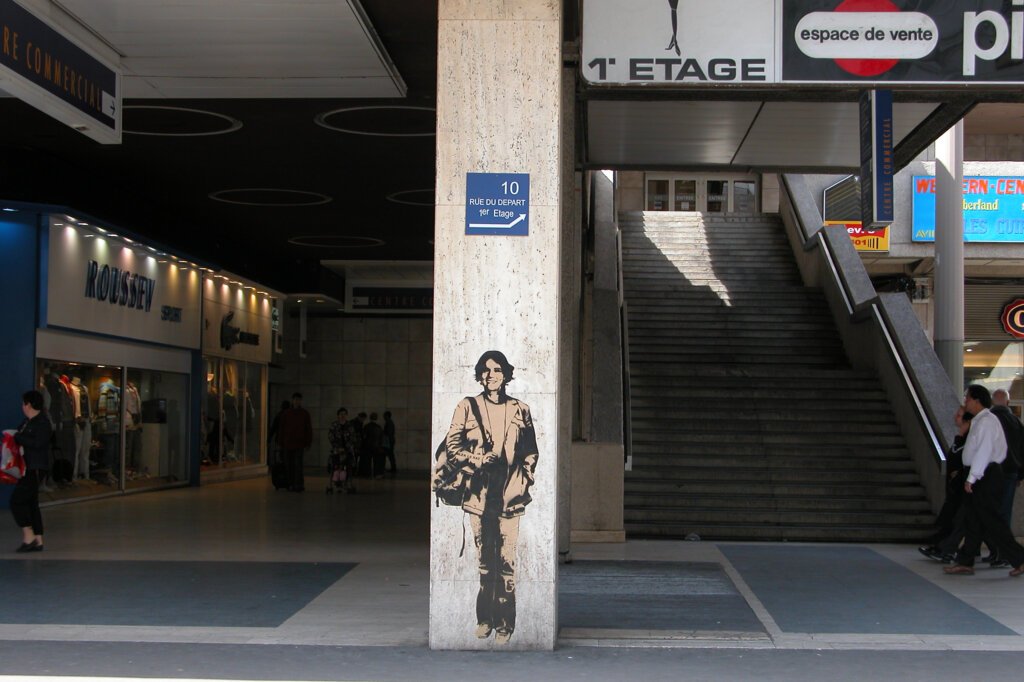
Image Courtesy of Blek le Rat ©Blek le Rat and ©Woodbury House
Her portrait appeared everywhere, from her workplace at Liberation next to cafés and offices of major newspapers. This activation aimed to attract the attention of the media and politicians to raise awareness of her situation, as everyone seemed to not be talking about it.
It worked. I got lots of interviews with Radio & TV. Florence was found, and after I met up with her and she thanked me. This made me understand how much impact I can have with my work and the power and responsibility an artist has worked in the public space.
The power of working on the streets is the most impactful form of art there is.
What is your artistic process like, from conceptualization to execution, when creating a new piece of stencil graffiti?
Blek le Rat: It is all variable subject to the idea I have and what I have to hand to bring the idea to reality. So, for example, if I have an idea for a stencil in mind, and a body shape and character in my head, I now need to produce this into stencil form. I may do this via drawing, taking photographs of people that fit this profile, photoshop etc.
Once I have the perfect shape, we can then create the stencil that replicates this. From here, I have to identify where I am going to position the stencil on the street to ensure it works for the environment and surroundings and will give the most impactful and correct message of the work.
Once I have identified the location, I have to visit with my stencil and create the final element by spraying the work on the streets. The actual spraying of the stencil on the streets is the quick element, the research and creation of the actual stencil design and ideology is what takes time.
You’ve mentioned that social and political issues often influence your work. Can you give an example of a piece that was particularly significant to you in this regard?
Blek le Rat: My stencil or work is never political, I am not interested in politics I am totally disinterested entirely in that.
My work is a social statement and one that stands out is again Florence Aubenas as I mentioned above, but also the series of beggars I did all around the world from Europe, USA, to Australia, to shed light on the issue of homelessness, sometimes images have a bigger impact than reality.
How do you feel about the comparison between your work and that of Banksy, and what do you think are the key differences and similarities between your artistic styles?
Blek le Rat: I think my work has influenced Banksy, but I do not think he has imitated me. I can see some comparable elements, but he has also put his own twist on the works he has produced and continues to do so.
The key difference would be Banksy likes to mix tragedy with humour, which is a really great mix and statement to make. My work is more stand-alone, and my aim is to make the most impactful message I can. I am not looking for humour within my work.
The key similarity is we both use the stencil form to make a social statement, and we have both used the rat many times, but we have delivered our works in different ways for sure.
Over the years, how have you seen the perception of street art evolve, both in Paris and globally?
Blek le Rat: This is the most ground-breaking art movement ever.
The evolution of street art since when I first got involved is unimaginable. For example, there were two or three artists in Paris doing street art back then; now, I could not even start to count how many there are today. The amount of street art that is being done right now in every corner of the world is in the thousands. You cannot even begin to imagine how impactful this is.
The best thing is, this is only the beginning, this only started with Cornbread in Philadelphia in 1969 & Taki183 in New York, and this is just going to get bigger and bigger and continue to evolve. It is so exciting to see what is next and what we have managed to create so far.
No one ever thought back then we would be where we are today, but I did. I always knew what I had seen in New York and what I was creating in Paris was the very start of something huge, I saw and envisaged the future for this powerful, impactful, mesmerising new genre of art.
What advice would you give to young, aspiring graffiti artists who want to make a mark in the world of street art?
Blek le Rat: Go on the streets, do not stay in your studio; the impact, exposure, and number of people who will see your work on the streets is amazing. Do not imitate, be inspired, but put your own ideology and character into your work to evolve this genre and make it even greater as we progress forward.
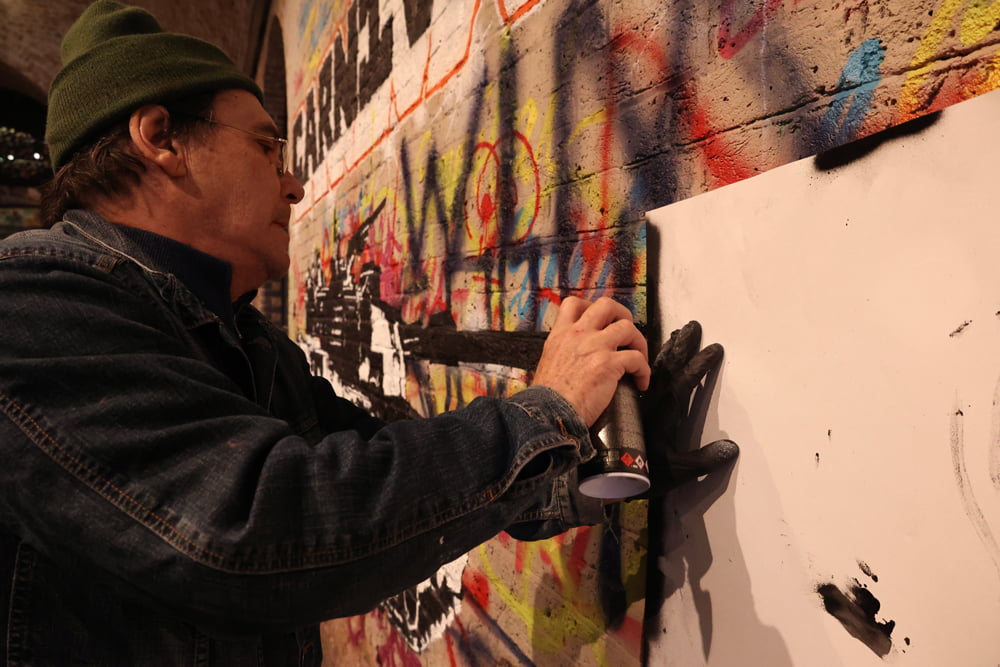
Image Courtesy of Blek le Rat ©Blek le Rat and ©Woodbury House
After years of being a Graffiti artist, what continues to motivate you to create art?
Blek le Rat: Legacy, I have given my life to street art, and this will continue until I die. It is my passion; it is my duty to inspire and make an impact with my art on the streets and in the gallery until I cannot do it a day longer.
How do you hope your work will be remembered, and what kind of legacy do you want to leave behind in the world of street art?
Blek le Rat: I hope my work will be remembered fondly by whoever witnessed it either on the streets or in the gallery. I want my work and my name to be remembered for playing a part in the evolution of the street art genre with the transition I made from what I witnessed in New York and fused my own form of graffiti with the stencil, paving the way for the next generation of artists to follow in my wake, whom I wish the very best to continue to take this art movement forward in the best possible light.
https://www.instagram.com/blekleratoriginal/
Blek le Rat, ‘The Return Of The Rat’, is until 12th April 2023 at Woodbury House
©2023 Blek le Rat, Woodbury House





